Cambridge IGCSE™ Co-ordinated Sciences Chemistry
STUDENT’S BOOK
Pages
Chris Sunley and Sam Goodman
CONTENTS 3 Chemistry Getting the best from the book ................ 4 1 States of matter......................................... 8 Solids, liquids and gases .......................................10 2 Atoms, elements and compounds .....22 Materials, atomic structure and the Periodic Table .............................................................................24 Ions and ionic bonds ..............................................36 Molecules and covalent bonds...........................45 Metallic bonding......................................................56 3 Stoichiometry ..........................................62 Formulae .....................................................................64 Practice questions for sections 1, 2 and 3 ........ 88 4 Electrochemistry.....................................94 Electrochemistry ......................................................96 5 Chemical energetics ...........................108 Exothermic and endothermic reactions.......110 6 Chemical reactions..............................122 Rate of reaction .....................................................124 Redox reactions .....................................................138 7 Acids, bases and salts .........................144 Acids, bases and salts ..........................................146 Practice questions for sections 4, 5, 6 and 7 .....................................................................160 8 The Periodic Table................................166 Arrangement of elements .................................168 Group I elements ..................................................174 Group VII elements...............................................181 Transition metals and noble gases .................189 9 Metals .....................................................194 Metals ....................................................................196 10 Chemistry of the environment ......214 Chemistry of the environment .....................216 Practice questions for sections 8, 9 and 10 ...................................................................228 11 Organic chemistry.............................234 Fuels .......................................................................236 Alkanes..................................................................242 Alkenes..................................................................248 Alcohols ................................................................258 Polymers ...............................................................265 Practice questions for section 11 ....................272 12 Experimental techniques and chemical analysis ..............................276 Experimental techniques ...............................278 Identi cation of ions and gases ...................289 Practice questions for section 12 ....................299 Developing experimental skills............303 Introduction ................................................................303 Apparatus and materials ........................................303 Plan an experiment ...................................................304 Make observations and measurements ............307 Interpret observations and data ..........................309 Evaluate methods .....................................................311 Preparing for assessment ......................315 Introduction ................................................................315 Examination techniques .........................................315 Periodic Table ...............................................................318 Glossary..........................................................................319 Answers..........................................................................325 Index ...............................................................................336 SamplePages
In this section you will explore the reactions of acids, bases and alkalis (which are bases that dissolve in water). In addition, you will learn about salts, which are made from the reaction of acids with bases and alkalis. You will probably have studied acids and alkalis previously and will certainly be familiar with their identi cation using indicators. A study of salts may be new to you, although it is very likely you have encountered common salt as sodium chloride. Once again you will be using chemical equations, as studied in Section 3, Stoichiometry.
Starting points
1. Give the names of the common acids you are familiar with. 2. Do you know the names of some common alkalis? 3. What indicators have you encountered in your previous work? 4. Do you know what name is given to the reaction of an acid with an alkali? SYLLABUS SECTIONS COVERED
SamplePages








Lime, which is calcium oxide, is used when it is necessary to reduce the acidity of soil before planting the crop

7.1 The characteristic properties of acids and bases 7.2 Oxides 7.3 Preparation of salts
Acids, bases and salts
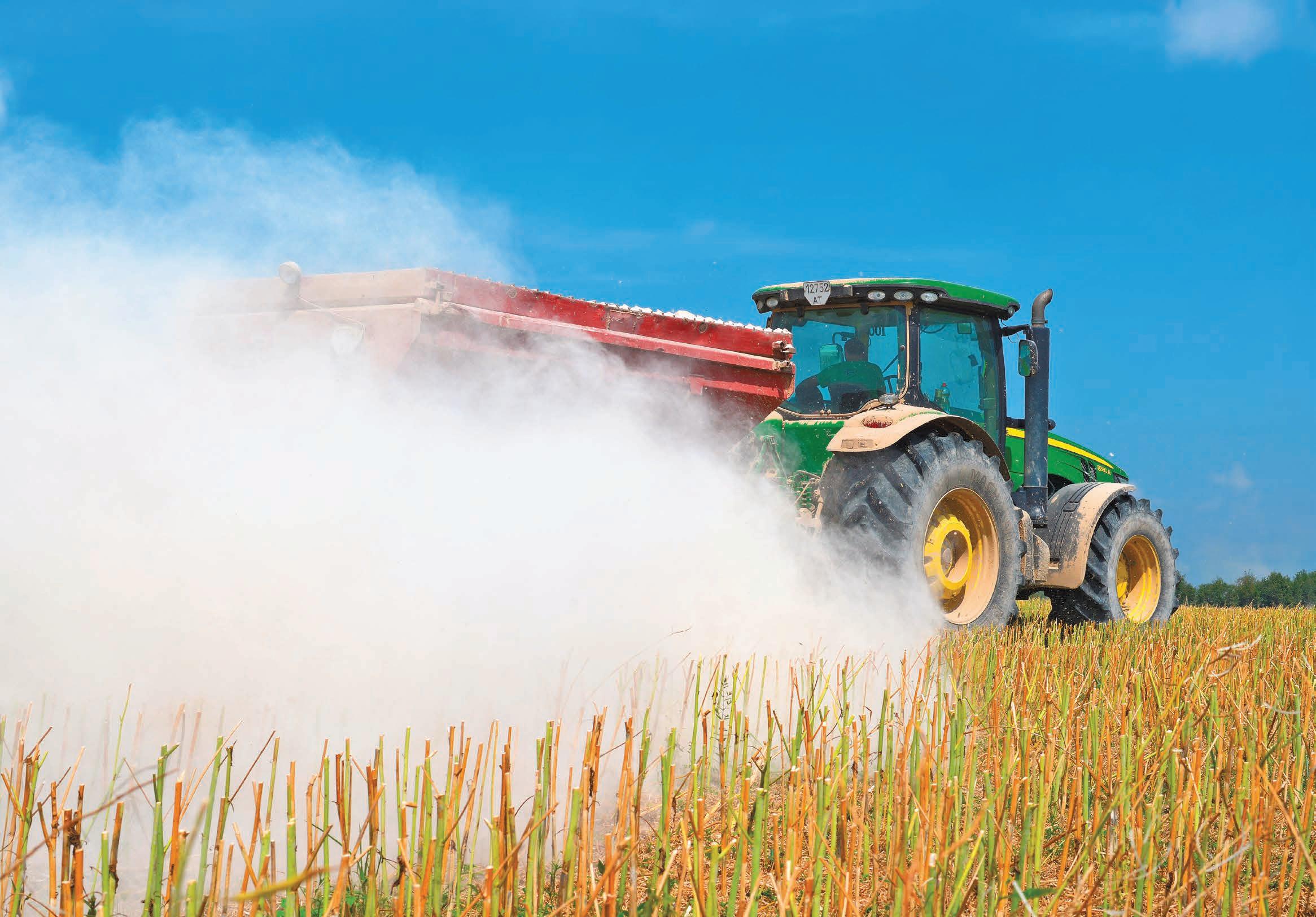
SamplePages
7
Acids, bases and salts
INTRODUCTION
Acids are commonly used in everyday life. Many of them, such as hydrochloric acid and sulfuric acid, are extremely toxic and corrosive. About 20 million tonnes of hydrochloric acid are manufactured worldwide each year. Some of this is used to make important chemicals such as PVC (polyvinyl chloride) plastic. Alkalis and bases are less common in everyday use, yet about 60 million tonnes of sodium hydroxide are produced worldwide each year and used in the manufacture of paper and soap. Sodium hydroxide is harmful and corrosive. Common salt, sodium chloride, is an example of a salt.
∆ Fig. 7.1 Sodium hydroxide.

KNOWLEDGE CHECK
✓ Common acids include hydrochloric acid and sulfuric acid.
✓ Vegetable dyes can be used as indicators to identify acids and alkalis.
✓ State symbols include (s), (l), (g) and (aq).
LEARNING OBJECTIVES
✓ Describe the characteristic properties of acids in terms of their reactions with metals, bases and carbonates.
✓ Describe acids in terms of their effect on litmus and methyl orange.
✓ State that bases are oxides or hydroxides of metals and that alkalis are soluble bases.
✓ Describe the characteristic properties of bases in terms of their reactions with acids.
✓ Describe alkalis in terms of their effect on litmus and methyl orange.
✓ Describe how to compare, neutrality, relative acidity and relative alkalinity in terms of colour and pH (using universal indicator paper).
✓ Describe the neutralisation reaction between an acid and an alkali to produce a salt and water. (The ionic equation for this reaction is not required.)
✓ Classify oxides as acidic, including SO2 and CO2, or basic, including CuO and CaO, related to metallic and non-metallic character.
✓ SUPPLEMENT Describe amphoteric oxides as oxides that react with acids and with bases to produce a salt and water.
✓ SUPPLEMENT Classify Al2O3 and ZnO as amphoteric oxides.
✓ Describe the preparation, separation and puri cation of soluble salts by reaction of an acid with: an alkali by titration; excess metal; excess insoluble base; excess insoluble carbonate (students do not need to know general solubility rules for salts).
✓ De ne a hydrated substance as a substance that is chemically combined with water and an anhydrous substance as a substance containing no water.
✓ SUPPLEMENT Describe the preparation of insoluble salts by precipitation (students do not need to know general solubility rules for salts).
146 ACIDS, B A SES A ND S A LTS
SamplePages
THE CHARACTERISTIC PROPERTIES OF ACIDS AND BASES
Aqueous solutions
When any substance dissolves in water, it forms an aqueous solution, shown by the state symbol (aq). Aqueous solutions can be acidic, alkaline or neutral. A neutral solution is neither acidic nor alkaline.
Indicators are used to tell if a solution is acidic, alkaline or neutral. They can be used either as liquids or in paper form, and they turn different colours with different solutions. There are different indicators that can be used.
The most common indicator is litmus. Its colours are shown in Table 7.1.
Colour of litmus Type of solution Red Acidic Blue Alkaline
∆ Table 7.1 Litmus.
Universal indicator can show how strongly acidic or how strongly alkaline a solution is because it has more colours than litmus. Each colour is linked to a number ranging from 0 (most strongly acidic solution) to 14 (most strongly alkaline solution). A neutral substance has a pH of 7. This range is called the pH scale.
Liquid drain cleaner, caustic soda Bleaches, oven cleaner
Soapy water Household ammonia (11.9)
Milk of magnesia (10.5)
Toothpaste (9.9)
Baking soda (8.4), seawater, eggs Examples of solutions and their respective pH Pure water (7)
Urine (6), milk (6.6)
Acid rain (5.6), black coffee (5)
Tomato juice (4.1)
Grapefruit and orange juice, soft drinks Lemon juice (2.3), vinegar (2.9)
Hydrochloric acid secreted from the stomach lining (1) Battery acid
∆
Fig. 7.2 The pH scale.
Methyl orange indicator is red in acid solution and yellow in alkaline solution.
147 THE C
HARACTE R ISTIC PROP ER TIES OF A CIDS A ND BA SES
14 13 12 11 10 9 8 7 6 5 4 3 2 1 0
SamplePages
What are acids?
Acids are substances that contain replaceable hydrogen atoms. These hydrogen atoms are replaced in chemical reactions by metal atoms, forming a compound known as a salt. Acids have pHs in the range 0–6 (must be less than 7 as this corresponds to neutral).
Acid name Acid formula
Hydrochloric acid
Nitric acid
HCl
HNO3
Sulfuric acid H2SO4
Phosphoric acid H3PO4
∆ Table 7.2 Common acids.
The typical reactions of acids include:
• Acid + metal makes a salt and hydrogen gas.
• Acid + carbonate makes a salt, carbon dioxide and water.
• Acid + alkali makes a salt and water.
What are bases and alkalis?
The oxides and hydroxides of metals are called bases.
If the oxide or hydroxide of a metal dissolves in water, it is also called an alkali. For example:
sodium + oxygen → sodium oxide
4Na(s) + O2(g) → 2Na2O(s)
sodium oxide + water → sodium hydroxide
Na2O(s) + H2O(l) → 2NaOH(aq)
Sodium oxide is a base because it is the oxide of the metal sodium. In addition, it reacts with water to make the alkali sodium hydroxide. Alkalis have pHs in the range 8–14 (must be more than 7 as this corresponds to neutral).
The typical reactions of bases include:
• Base + acids make a salt and water.
QUESTIONS
1. Two solutions of the same concentration are tested with universal indicator paper. Solution A has a pH of 8 and solution B has a pH of 14. Explain what this tells you about the two solutions.
2. Methyl orange is added to a solution and the solution turns red. Explain what this tells you about the solution.
3. Calcium oxide is an example of a base. Suggest how we know this.
148 ACIDS, B A SES A ND S A LTS
SamplePages
CONTEXT THE IMPORTANCE OF CONTROLLING ACIDITY IN SOIL
Different plants grow better in different types of soil. The pH of a soil is an important factor in the growth of different plants – some plants prefer slightly acidic conditions and others slightly alkaline conditions.
If soil is too acidic then it can be neutralised using quicklime. Quicklime is made from limestone, which is quarried from limestone rocks. It is heated in lime kilns at 1200 °C to make calcium oxide or quicklime: 1200 °C limestone quicklime + carbon dioxide CaCO3(s) → CaO(s) + CO2(g)
When quicklime is added to water, it makes calcium hydroxide, which is an alkali and so can neutralise the acidic soil: quicklime + water → slaked lime CaO(s) + H2O(l) → Ca(OH)2(s)
Adding fertilisers to soil can also affect the pH and so the soil may have to be treated by adding acids or alkalis. The pH of soil can be measured by taking a small sample, putting it in a test-tube with distilled water and adding indicator solution or using indicator paper. The pH can be found from a pH chart.
Challenge Question: Calculate how much quicklime (calcium oxide) can be made from 1 kg of limestone (calcium carbonate). (Ar: C = 12, O = 16, Ca = 40)
OXIDES
The oxides of elements can often be made by heating the element in air or oxygen. For example, the metal magnesium burns in oxygen to form magnesium oxide: magnesium + oxygen → magnesium oxide 2Mg(s) + O2(g) → 2MgO(s)
Magnesium oxide forms as a white solid. When distilled water is added to the ash and the mixture is tested with universal indicator, the pH is greater than 7 – the oxide has formed an alkaline solution. ∆ Fig. 7.3 Magnesium burning in oxygen. ∆ Fig. 7.4 Magnesium oxide is a white solid.
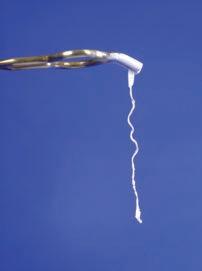
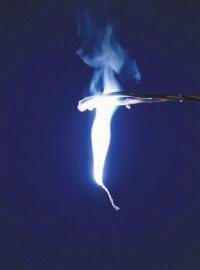
149 OXIDES
● SCIENCE IN
SamplePages
When sulfur is burned in oxygen, sulfur dioxide gas is formed: sulfur + oxygen → sulfur dioxide S(s) + O2(g) → SO2(g)
When sulfur dioxide is dissolved in water and then tested with universal indicator solution, the pH is less than 7 – the oxide has formed an acidic solution. The oxides of most elements can be classi ed as either basic oxides or acidic oxides. Copper(II) oxide and calcium oxide are examples of basic oxides. Sulfur dioxide and carbon dioxide are examples of acidic oxides. Some elements form neutral oxides. For example, water is a neutral oxide. Basic oxides that dissolve in water are called alkalis. Oxides that do not dissolve in water cannot be identi ed using the pH of their solutions. For insoluble oxides, the test is seeing if they will react with hydrochloric acid, HCl (these would be basic oxides) or sodium hydroxide solution, NaOH (these would be acidic oxides). Oxides that do not react with hydrochloric acid or sodium hydroxide are neutral oxides.
Most metal oxides are basic oxides, such as CaO, MgO, CuO, Na2O. Basic oxides react with acids (neutralisation): acid + base → a salt + water 2HCl(aq) + MgO(s) → MgCl2(aq) + H2O(l)
Most non-metal oxides are acidic, for example: NO2, SO2, SO3, CO2, P2O5
Acidic oxides dissolve in water to form acids, for example sulfuric acid (H2SO4): SO3(g) + H2O(l) → H2SO4(aq)
Oxide Type of oxide pH of solutionOther reactions of the oxide Metal oxideBasicMore than 7 (alkaline) Reacts with an acid to make a salt + water Non-metal oxide AcidicLess than 7 (acidic) Reacts with a base to make a salt + water ∆ Table 7.3 Acidic and basic oxides.
SUPPLEMENT
Amphoteric oxides are the oxides of less reactive metals, for example, Al2O3 and ZnO. They can behave as both acidic oxides and basic oxides, so react with both bases and acids.
QUESTIONS
1. Suggest whether potassium oxide is a basic oxide or acidic oxide. Explain your answer.
2. SUPPLEMENT Contrast the difference between a basic oxide and an amphoteric oxide.
3. Balance the following equation for the reaction of potassium with oxygen to form potassium oxide: _K(s) + _O2(g) → _K2O(s)
150 ACIDS, B A SES A ND S A LTS
SamplePages
SALTS
Acids contain replaceable hydrogen atoms. When metal atoms take the place of hydrogen atoms, a compound called a salt is formed. The names of salts have two parts, as shown in Fig. 7.5. Table 7.4 shows the four most common acids and their salt names.
sodium chloride (NaCl)
the name of the metal that replaced the hydrogen
the part of the salt name showing which acid was used
∆ Fig. 7.5 A salt – sodium chloride.
Acid Salt name (ion)
Hydrochloric (HCl) Chloride (Cl ) Nitric (HNO3) Nitrate (NO3 ) Sulfuric (H2SO4) Sulfate (SO42−)
Phosphoric (H3PO4) Phosphate (PO43−)
∆ Table 7.4 Common acids and their salt names.
∆ Fig. 7.6. Sodium chloride crystals.

∆ Fig. 7.7 Copper(II) sulfate crystals.
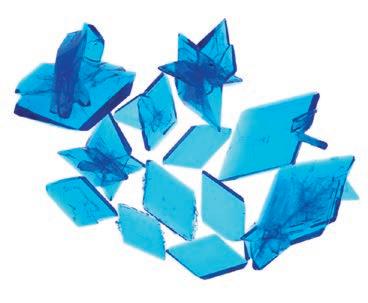
Salts are ionic compounds. The names of these compounds are created by taking the rst part of the name from the metal ion, which is a positive ion (cation), and the second part of the name from the acid, which is a negative ion (anion). For example: copper(II) sulfate: Cu2+ and SO42− → CuSO4 cation anion salt
SamplePages
Making salts
There are ve common methods for making salts. Four of these make soluble salts and one makes insoluble salts.
REMEMBER
Some salts are chemically combined with water – they are hydrated. A salt that is not combined with water is anhydrous. A good example of this is copper(II) sulfate. As CuSO4 the salt is anhydrous. As CuSO4•5H2O the salt is hydrated.
151 SA LTS
Making soluble salts
1. acid + alkali → a salt + water
For example: HCl(aq) + NaOH(aq) → NaCl(aq) + H2O(l)
2. acid + base → a salt + water
For example: H2SO4(aq) + CuO(s) → CuSO4(aq) + H2O(l)
3. acid + carbonate → a salt + water + carbon dioxide
For example: 2HNO3(aq) + CuCO3(s) → Cu(NO3)2(aq) + H2O(l) + CO2(g)
4. acid + metal → a salt + hydrogen
For example: 2HCl(aq) + Mg(s) → MgCl2(aq) + H2(g)
Here is a shortcut for remembering the four general equations above. Remember the initials of the reactants:
A (acid) + A (alkali)
A (acid) + B (base)
A (acid) + C (carbonate)
A (acid) + M (metal)
The symbol ‘(aq)’ after the formula of the salt shows that it is a soluble salt. When exactly the right volumes of acid react with an alkali or base to produce a neutral solution, this is called neutralisation. An indicator is used to nd out when neutralisation occurs.
QUESTIONS
1. Complete the word equations for the following reactions to form a salt: a) magnesium + sulfuric acid = b) copper(II) oxide + hydrochloric acid = c) copper(II) carbonate + nitric acid =
2. SUPPLEMENT Complete the following ionic equations:
a) Mg + 2H+ = b) CO32– + 2H+ =
152 ACIDS, B A SES A ND S A LTS
SamplePages
In the laboratory
Of the four methods for making soluble salts, shown by the symbol (aq), only one uses two solutions:
1. acid(aq) + alkali(aq) → a salt(aq) + water(l) The other three methods involve adding a solid(s) to a solution(aq):
2. acid(aq) + base(s) → a salt(aq) + water(l)
3. acid(aq) + carbonate(s) → a salt(aq) + water(l) + carbon dioxide(g)
4. acid(aq) + metal(s) → a salt(aq) + hydrogen(g)
Method 1 involves the titration method to accurately measure volumes of the acid and alkali solutions. An indicator is used to show when exact quantities of acid and alkali have been mixed. The procedure is then repeated using the same exact volumes of acid and alkali, but without the indicator. The resulting solution is evaporated to the point of crystallisation, then left to cool and the salt to crystallise.
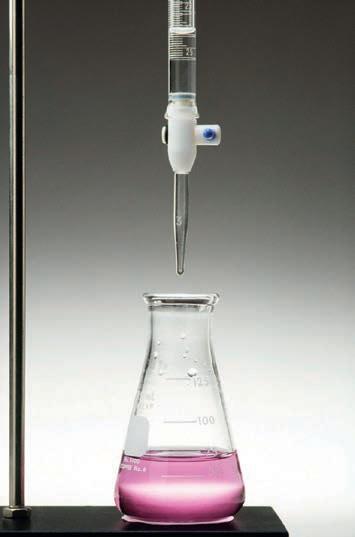
∆ Fig. 7.8 Using the neutralisation method for a titration.
The general procedure used for each of the methods 2, 3 and 4 is the same:
• The solid (insoluble base, insoluble carbonate or metal) is added to the acid with stirring until no more solid will react. The solid is in excess. Heating may be necessary.
• The mixture is ltered to remove unreacted solid and the solution is collected as the ltrate in an evaporating dish.
add solid (base/carbonate/metal)
filter
SamplePages
evaporating dish evaporate to reduce volume of solution filter
∆ Fig. 7.9 Making soluble salts from solids.
transfer hot liquid to dish
153 SA LTS
• The solution is evaporated to the point of crystallisation and is then left to cool and the salt to crystallise. The process is summarised in Fig. 7.9: acidacid solid in excess (salt formed in the solution)
of f excess solid crystals form af ter leaving to cool and when solution is saturated
QUESTIONS
1. Explain what a salt is.
2. Which acid would you use to make a sample of sodium sulfate?
3. What is the name of the salt formed when calcium carbonate reacts with nitric acid?
4. Explain the term neutralisation.
SUPPLEMENT
Making insoluble salts
If two solutions of soluble salts are mixed together to form two new salts, and one of the products is insoluble, the insoluble salt forms a precipitate – a solid made in solution. This process is called precipitation. The general equation is: soluble salt + soluble salt → insoluble salt (precipitate) + soluble salt
For example:
Na2CO3(aq) + CuSO4(aq) → CuCO3(s) + Na2SO4(aq)
The state symbols show the salts in solution as (aq) and the precipitate – the insoluble salt – as (s).
In the laboratory
The practical method involves making a precipitate of an insoluble salt by mixing solutions of two soluble salts.
The procedure is as follows:
1. The two solutions of soluble salts are mixed together and a precipitate forms.
2. The precipitate is separated by ltration.
3. The precipitate is then washed with a little cold water and allowed to dry. The process is summarised in Fig. 7.10.
add second soluble salt solution
wash the residue in a lit tle cold water and leave to dry
insoluble salt formed as a precipitate (solid)
soluble salt solution filter to collect the salt
∆ Fig. 7.10 Making an insoluble salt.
damp filter paper and salt insoluble salt
154 ACIDS, B A SES A ND S A LTS
SamplePages
QUESTIONS
1. SUPPLEMENT Explain the term precipitation reaction.
2. SUPPLEMENT When preparing an insoluble salt state what process is used to separate the insoluble salt from any soluble salts.
3. SUPPLEMENT Explain why the insoluble salt is washed with a little cold water before it is left to dry.
4. SUPPLEMENT Lead(II) chloride is an insoluble salt and can be prepared by mixing solutions of lead(II) nitrate and sodium chloride.
a) Write a word equation for the reaction.
b) Write a balanced equation with state symbols for the reaction.
●SCIENCE IN CONTEXT SOME INTERESTING FACTS ABOUT ACIDS AND ALKALIS
1. Pure sulfuric acid is a clear, oily, highly corrosive liquid. It was well known to Islamic, Greek and Roman scholars in the ancient world, when it was called ‘oil of vitriol’. Although pure sulfuric acid does not occur naturally on Earth because of its attraction for water, dilute sulfuric acid is found in acid rain and in the upper atmosphere of the planet Venus. It has a wide range of industrial uses from making fertilisers, dyes, paper and pharmaceuticals to batteries, steel and iron. Sulfuric acid is not toxic but it is highly reactive with water, in a strongly exothermic reaction. It can cause severe burns. The acid must be stored in glass containers (never plastic or metal) and handled with extreme care.
∆ Fig. 7.11 A wasp.
2. Hydrochloric acid, although classi ed as toxic and corrosive, is part of the gastric acid in the stomach and is involved in digestion. Excess acid in the stomach can cause indigestion but ‘anti-acid’ (alkali) medications can be taken to neutralise this.
3. Perhaps the strongest acid is a mixture of nitric acid and hydrochloric acid, known as ‘aqua regia’ because it reacts with the ‘royal’ metals. Unlike other acids, it reacts with very unreactive metals such as gold and platinum. However, some metals like titanium and silver are not affected.
4. Formic acid (now called methanoic acid) is in the venom of ant and bee stings. Such stings can be relieved by (or neutralised) with an alkali such as sodium bicarbonate (sodium hydrogencarbonate). Wasp stings, however, contain an alkali and so need to be neutralised by a weak acid such as vinegar.

155 SA LTS
SamplePages
The differences can be remembered using:
Bee – Bicarb
Wasp (W looks like two Vs) – Vinegar
Challenge Question: You can buy liquids which can be used to soothe skin after insect bites and stings. One particular product contains the following ingredients: ammonia, liquid paraf n and water. Consider whether you would use this product to soothe your skin after a wasp sting. Explain your answer.
Developing practical skills
A student wanted to make a sample of copper(II) sulfate crystals, CuSO4•5H2O. She used the following steps in her method. She put on eye protection and warmed 50 cm3 of dilute sulfuric acid in a 250 cm3 beaker and then copper(II) oxide was added a spatula at a time, stirring the reaction mixture with a glass rod. When no more copper(II) oxide would react, she ltered the mixture and collected the copper(II) sulfate solution in an evaporating basin. She then heated the solution in the evaporating basin until she could see crystals starting to form and then allowed it to cool.
After several hours, blue crystals of copper(II) sulfate had formed. She drained off any remaining liquid and dried the crystals between lter papers. She washed her hands after she had nished.
Using and organising techniques, apparatus and materials
1. Copper(II) sulfate crystals are ‘hydrated’. Explain what this means.
2. Draw a diagram showing the apparatus the student could have used to lter the mixture.
3. Give the general name given to a liquid that passes through a lter paper.
4. Explain how the student could have tested for the crystallisation point while heating the ltrate.
SamplePages
Observing, measuring and recording
5. State the colour of copper(II) oxide.
6. Describe the colour of the solution the student evaporated?
Evaluating methods
7. While heating the solution in the evaporating dish the student noticed some very pale blue powder around the edges of the evaporating basin. Suggest what you think this powder was and explain how it had formed.
156 ACIDS, B A SES A ND S A LTS
End of topic checklist
Key terms
acid, acidic oxide, alkali, anhydrous, base, basic oxide, crystallisation, ltrate, hydrated, indicator, insoluble, litmus, neutralisation, oxide, pH scale, salt, soluble, titration, universal indicator
SUPPLEMENT amphoteric oxide, precipitation
During your study of this topic you should have learned:
❍ How to describe the characteristic properties of acids as reactions with metals, bases, carbonates and the effects on litmus and methyl orange.
❍ How to describe the characteristic properties of bases (oxides or hydroxides of metals) as reactions with acids and with and the effects on litmus and methyl orange.
❍ How to compare neutrality, relative acidity and alkalinity using universal indicator.
❍ How to classify oxides as either acidic (SO2 and CO2) or basic (CuO or CaO), related to metallic and non-metallic character.
❍ How to describe the preparation, separation and puri cation of soluble salts as prepared by the following reactions:
● acid + alkali (titration)
● acid + metal
● acid + insoluble base
● acid + insoluble carbonate.
❍
❍
❍
How to de ne the terms hydrated and anhydrous.
SUPPLEMENT How to de ne amphoteric oxides, with Al2O3 and ZnO as examples.
SUPPLEMENT How to describe the preparation of insoluble salts by precipitation.
157 ACIDS, B A SES A ND S A LTS
SamplePages
End of topic questions
1. Which one of these statements about hydrochloric acid is correct?
A It has a pH of 7.
B It turns litmus paper blue.
C It causes methyl orange to turn yellow.
D It has a pH of 1.
2. a) Explain what an indicator is.
b) State what the pH scale is.
c) State what the following pH numbers indicate about a solution that has been tested: i) pH 6 ii) pH 8 iii) pH 14.
3. a) De ne the term ‘acid’.
b) De ne the term ‘alkali’.
c) State the name of the process when an acid reacts with an alkali to form water.
4. Calcium chloride, a soluble salt, can be made from calcium oxide and dilute hydrochloric acid.
a) State what type of chemical calcium oxide is.
b) State what type of chemical calcium chloride is.
c) Describe the different stages in the preparation of calcium chloride crystals.
d) SUPPLEMENT Write a fully balanced equation, including symbols, for the reaction between calcium oxide and dilute hydrochloric acid.
158 ACIDS, B A SES A ND S A LTS
SamplePages
5. SUPPLEMENT Barium sulfate is an insoluble salt and can be made using a precipitation reaction.
a) State what acid can be used to make barium sulfate.
b) State what other chemical could be used to make barium sulfate.
c) Describe the different stages in the preparation of a dry sample of barium sulfate.
d) Write a fully balanced equation, including state symbols, for the reaction to make barium sulfate.
6. SUPPLEMENT Copy and complete the following equations and include state symbols:
a) 2KOH(aq) + H2SO4(aq) → —— + ——
b) 2HCl(aq) + MgO(s) → —— + ——
c) 2HNO3(aq) + BaCO3(s) → —— + ——
d) 2HCl(aq) + Zn(s) → —— + ——
e) ZnCl2(aq) + K2CO3(aq) → —— + ——
159 ACIDS, B A SES A ND S A LTS
SamplePages
Practice questions for Sections 4, 5, 6 and 7
Example answer
Note: Practice questions, sample answers and comments have been written by the authors. The marks awarded for these questions indicate the level of detail required in the answers. In examinations, the way marks are awarded may be different. References to assessment and/or assessment preparation are the publisher's interpretation of the syllabus requirements and may not fully re ect the approach of Cambridge Assessment International Education.
Question 1 SUPPLEMENT
Solutions of lead(II) nitrate and potassium iodide react together to make the insoluble substance lead(II) iodide.
The equation for the reaction is Pb(NO3)2(aq) + 2KI(aq) → 2KNO3(aq) + PbI2(s)
COMMENTS
a) i) Correct point marked.
ii) Correct explanation. Also correct would be tube not being vertical when being set up so precipitate not level.
iii) Correct response.
b) i) Correct response.
ii) Correct response – also correct is ‘lead(II) nitrate in excess’.
c) i) Correct reading of ruler.
ii) Answer is 3.9 cm3 – the horizontal axis scale has been misread and so the incorrect unit has been given.
An investigation was carried out to nd how much precipitate formed with different volumes of lead(II) nitrate solution.
A student measured out 15 cm3 of potassium iodide solution using a measuring cylinder. He poured this solution in to a clean boiling tube. Using a clean measuring cylinder, he measured out 2 cm3 of lead(II) nitrate solution (of the same concentration as the potassium iodide solution). He added this to the potassium iodide solution.
A cloudy yellow mixture formed and the precipitate was left to settle. The student then measured the height (in cm) of the precipitate using a ruler.
The student repeated the experiment using different volumes of lead(II) nitrate solution. The graph shows the results obtained.
160 PRACTICE QUESTIONS
SamplePages
a) i) On the graph, circle the point that seems to be anomalous. (1)
ii) Explain two things that the student may have done in the experiment to give this anomalous result.
Precipitate not settled ✓ 1 Because not left long enough ✓ 1 (2) iii) Explain why the graph line must go through (0, 0). Cannot have a precipitate if no lead nitrate added yet. ✓ 1 (1)
8
solution of soluble salts precipitate of solid lead(II) iodide
7
6
5
4
3
2
b) Suggest a reason why the height of the precipitate stops increasing. No more potassium iodide left to react. ✓ 1 (1) 1
c) i) How much precipitate has been made in the tube drawn on the right?
1.5 cm ✓ 1 (1)
ii) Use the graph to nd the volume of lead(II) nitrate solution needed to make this amount of precipitate.
2.9 cm ✗ (1)
161 PRACTICE QUESTIONS
0 0 1 2 Height of precipitate / cm
Volume of lead(II) nitrate solution added / cm3 3 4 2 4 6 8 10 12 14 16 ✓ × × × × × × ××
SamplePages
d) After he had plotted the graph, the student decided he should obtain some more results.
i) Suggest what volumes of lead(II) nitrate solution he should use.
Between 6 cm3 and 10 cm3✓ 1 (1)
ii) Explain why he should use these volumes. Need to know exactly where the graph levels off ✓ 1 (1)
d) i) Correct response.
ii) Correct – this is the purpose of the experiment.
e) The answer could have been improved by noting that the ltered-o precipitate needs to be washed and ‘dried’ before being weighed.
e) Suggest a different method for measuring the amount of precipitate formed.
Filter ✓ 1 off each precipitate and weigh it✓ 1 (4)
(Total 13 marks) 10 13
Question 2
Copper(II) oxide reacts with carbon to form copper and carbon dioxide.
2CuO(s) + C(s) → 2Cu(s) + CO2(g)
Identify which of the following statements is correct:
A The carbon has been reduced.
B The copper(II) oxide has been oxidised.
C The copper(II) oxide has been reduced.
D The carbon dioxide has been oxidised. (1)
(Total 1 mark)
Question 3 SUPPLEMENT
Dilute nitric acid reacts with marble chips to produce carbon dioxide. The equation is given below:
2HNO3(aq) + CaCO3(s) → Ca(NO3)2(aq) + H2O(l) + CO2(g)
Some students investigated the effect of changing the temperature of the nitric acid on the rate of the reaction. The method is:
• Use a measuring cylinder to pour 50 cm3 of dilute nitric acid into a conical ask.
• Heat the acid to the required temperature.
• Put the ask on the balance.
162 PRACTICE QUESTIONS
SamplePages
• Add 15 g (an excess) of marble chips to the ask.
• Time how long it takes for the mass to decrease by 1.00 g.
• Repeat the experiment at different temperatures. The students’ results are shown in the table.
Temperature of acid (°C) Time to lose 1.00 g (s) 20 93 33 68 44 66 55 40 67 30 76 25
a) i) Draw a graph of the results. (3) ii) One of the points is inaccurate. Circle this point on your graph. (1) iii) Suggest a possible cause for this inaccurate result. (1)
b) Use the graph to determine the times taken to lose 1.00 g at 40 °C and 60 °C. (2)
c) The rate of the reaction can be found using the equation:
rate of reaction = mass lost time taken to lose mass
i) Use this equation and your results from b) to calculate the rates of reaction at 40 °C and 60 °C. (2)
ii) State the unit for these rates. (1) iii) State how the rate of reaction changes when the temperature increases. (1)
iv) Explain in terms of particles and collisions why the rate changes when the temperature increases. (1)
(Total 12 marks)
Question 4 SUPPLEMENT
The diagram shows the apparatus used to electrolyse lead(II) bromide.
a) The wires connected to the electrodes are made of copper. Explain why copper conducts electricity. (1)
b) Explain why electrolysis does not occur unless the lead(II) bromide is molten. (2)
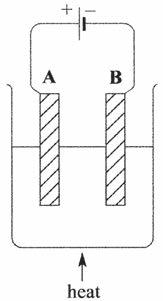
163 PRACTICE QUESTIONS
SamplePages
c) The reactions occurring at the electrodes can be represented by the equations shown in the table.
Copy and complete the table to show the electrode (A or B) at which each reaction occurs, and the type of reaction occurring (oxidation or reduction). (2)
Electrode reaction Electrode Type of reaction
Pb2+ + 2e → Pb 2Br → Br2 + 2e
Question 5
(Total 5 marks)
Read the following instructions for the preparation of hydrated nickel(II) sulfate (NiSO4•7H2O), then answer the questions that follow.
• Put 25 cm3 of dilute sulfuric acid in a beaker.
• Heat the sulfuric acid until it is just boiling and then add a small amount of nickel(II) carbonate.
• When the nickel carbonate has dissolved, stop heating, then add a little more nickel carbonate. Continue in this way until nickel carbonate is in excess.
• Filter the hot mixture into a clean beaker.
• Make the hydrated nickel(II) sulfate crystals from the nickel(II) sulfate solution.
The equation for the reaction is NiCO3(s) + H2SO4(aq) → NiSO4(aq) + CO2 (g) + H2O(l)
a) State what piece of apparatus would you use to measure out 25 cm3 of sulfuric acid. (1)
b) Explain why the nickel(II) carbonate is added in excess. (1)
c) When nickel(II) carbonate is added to sulfuric acid, there is zzing. Explain why. (1)
d) After ltration, which one of the following describes the nickel(II) sulfate in the beaker? Select the correct answer.
crystals ltrate precipitate water (1)
e) Explain how you would obtain pure dry crystals of hydrated nickel(II) sulfate from the solution of nickel(II) sulfate. (2)
(Total 6 marks)
164 PRACTICE QUESTIONS
SamplePages


















